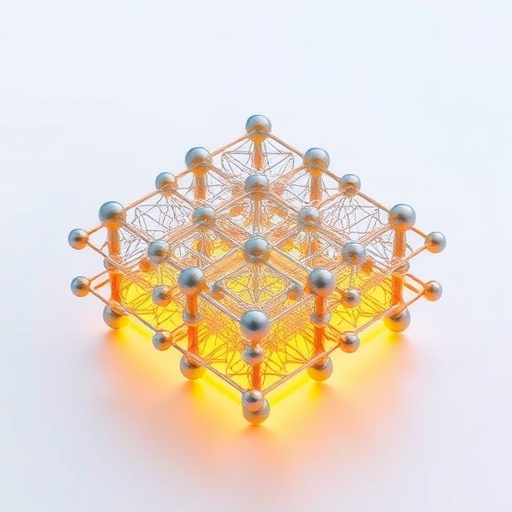In the relentless pursuit of sustainable and efficient energy storage solutions, aqueous zinc-ion batteries (AZIBs) have emerged as a promising candidate, offering advantages such as safety, low cost, and environmental friendliness. Despite this potential, widespread adoption has been hindered by one critical limitation—the inherent instability of the zinc anode. The zinc anode commonly suffers from dendritic growth and side reactions, which compromise battery life and performance, particularly under extreme temperature conditions. This technological bottleneck has motivated scientists to explore innovative materials and surface engineering techniques to stabilize Zn anodes, thereby unlocking the full potential of AZIBs for grid-scale energy storage.
A team of researchers has now pushed the frontier of battery science by engineering a novel BiOCl/Bi heterostructure that self-assembles on the zinc anode surface, providing remarkable protection and regulation. This advanced interface introduces a synergistic interplay between ion transport and an intrinsic electric field, a dual-action system that addresses the root causes of anode degradation. Central to its design is the fabrication of a Bi/BiOCl protective layer, which not only acts as a physical barrier but also plays an active role in modulating zinc ion deposition kinetics and suppressing parasitic reactions. The careful orchestration of these factors achieves a transformational leap in battery durability and reliability.
At the heart of this breakthrough lies the establishment of a bidirectional ion-electric field coupling. The BiOCl component forms an intimate heterostructure with metallic bismuth (Bi), generating an internal electric field that exerts directional control over zinc ions. This field acts as a dynamic shield, ensuring uniform zinc ion flux and deposition across the anode surface. Preventing localized ion concentration gradients mitigates the nucleation and growth of zinc dendrites—needle-like metallic protrusions that penetrate the separator, causing internal short circuits and eventual cell failure. The electric field’s role as an active guiding force signifies a new paradigm in battery interfaces, where the anode surface becomes an intelligent participant in electrochemical processes.
Complementing the electric field-induced regulation, the metallic Bi sites embedded within the heterostructure serve as potent nucleation centers for zinc ion reduction. These Bi sites exhibit strong affinity for zinc ions, effectively lowering the activation energy barrier for Zn plating and stripping reactions. This catalytic effect enhances the overall reversibility and kinetics of the electrodeposition process, leading to faster charging and discharging rates with minimal energy loss. By combining these two mechanisms—electric field guidance and catalytic seeding—the system achieves a meticulously balanced interface that sustains high performance under diverse and demanding operational environments.
Experimental validation underscores the robustness of this engineered anode. The batteries constructed with the BiOCl/Bi heterostructured zinc anode could endure over 2,500 hours of continuous cycling under strenuous test conditions without significant capacity degradation. More impressively, these batteries demonstrated stability across an exceptionally broad temperature range, maintaining performance from the icy depths of -20 °C to the blistering heat of 70 °C. This thermal tolerance marks a critical advancement toward practical applications where batteries must reliably operate in fluctuating environmental conditions without compromising safety or efficiency.
The implications of these findings are profound for energy infrastructure on a global scale. Massive energy storage systems—critical for buffering renewable energy sources like solar and wind—require batteries that combine affordability, safety, and endurance. By resolving the zinc anode’s intrinsic limitations, this BiOCl/Bi heterostructure paves the way for AZIBs to fulfill their promise as safe, scalable, and cost-effective solutions. Furthermore, the long cycling life verified by hybrid capacitor prototypes exceeding 15,000 cycles suggests adaptability of the technology beyond traditional battery formats, encompassing fast-response energy storage devices.
From a materials science perspective, the self-forming nature of the Bi/BiOCl protective layer represents a pragmatic advantage in manufacturing. Unlike complex coating procedures often needed in battery electrode fabrication, the in situ growth mechanism simplifies production, reduces costs, and enhances compositional uniformity. This scalability is essential for transitioning laboratory breakthroughs into commercial viability, promoting faster integration into the energy storage market.
The integration of this heterostructure also addresses long-standing parasitic reactions that plague zinc anodes, such as hydrogen evolution. By establishing an energetic barrier, the BiOCl layer inhibits unwanted side reactions that consume electrolyte and active material, which could otherwise lead to swelling, gas buildup, and loss of capacity. This chemical stability enhances the overall safety profile, making these batteries more dependable in real-world conditions, including extreme thermal environments.
Looking ahead, the principle of bidirectional ion-electric field synergy opens intriguing avenues for future battery design. Extending this approach to other aqueous and solid-state battery chemistries could yield similar enhancements in ion transport control and electrode stability. The conceptual advance also invites further exploration into heterostructured interfaces combining layered materials and metals to tailor electrochemical properties with high precision.
In summary, the advent of the BiOCl/Bi heterostructured zinc anode constitutes a landmark innovation in aqueous zinc-ion battery technology. By harmonizing electric field-driven ion guidance and catalytic nucleation, this dual-action strategy robustly overcomes the critical limitations of dendrite formation and side reactions while delivering exceptional longevity and thermal adaptability. This development not only revitalizes the prospects of AZIBs for grid-level energy storage but also signals a broader shift toward intelligent electrode interface engineering as a foundation for next-generation rechargeable batteries. As global energy demands intensify and sustainability becomes paramount, breakthroughs like this will be pivotal in realizing a resilient and clean energy future.
Subject of Research: Aqueous zinc-ion batteries (AZIBs) and zinc anode stabilization via BiOCl/Bi heterostructure
Article Title: Bidirectional Ion–Electric Field Synergy via In Situ Grown BiOCl/Bi Heterostructure Enabling Ultra–Stable Zinc Anodes Across Wide Temperatures
Web References: DOI: 10.1016/j.scib.2025.10.004
References: Science Bulletin journal article published by Science China Press
Image Credits: ©Science China Press
Keywords
Aqueous zinc-ion battery; zinc anode; BiOCl/Bi heterostructure; dendrite suppression; ion-electric field synergy; in situ growth; zinc plating; electrode stability; battery cycling life; thermal stability; parasitic reaction inhibition; energy storage technology




